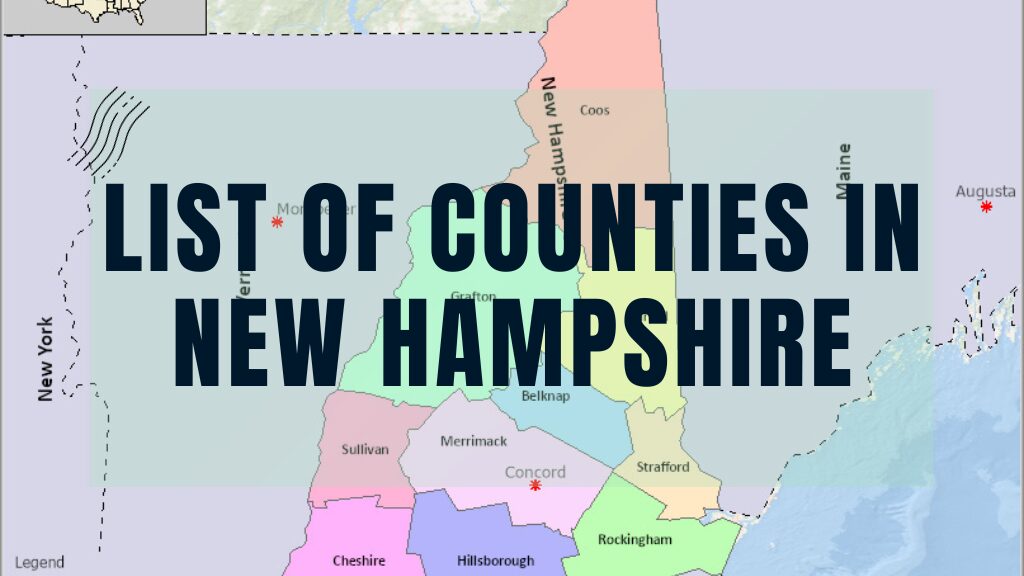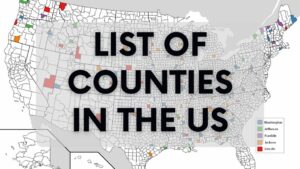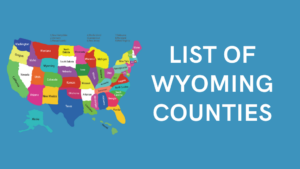New Hampshire, one of the six states that make up New England, is known for its scenic beauty, historical significance, and strong community ties. To better understand the state’s governance and local divisions, it is essential to explore the list of counties in New Hampshire. These counties play a vital role in local administration, legal jurisdiction, and community identity. Each one carries a unique history, demographic composition, and cultural influence that contributes to the overall character of the Granite State.
Understanding New Hampshire’s County System
Counties in New Hampshire were created to establish local governance, provide legal and judicial structures, and help organize community resources. While the state government retains a significant amount of authority, counties manage essential services such as courts, jails, deeds, and certain administrative functions. Unlike larger states where county governments hold extensive power, New Hampshire counties have relatively limited authority, but they remain an important part of regional administration and identity.
Historical Background of Counties in New Hampshire
The history of New Hampshire counties stretches back to the colonial era. The first counties were established in 1769 by the New Hampshire Provincial Assembly, with Rockingham, Strafford, Hillsborough, and Cheshire being the original four. At that time, settlers needed a way to manage courts, deeds, and local disputes without traveling across difficult terrain. Counties became the answer to these needs, serving as legal and administrative centers.
As settlement expanded northward and westward, new counties were carved out. In 1771, Grafton and Belknap were added to accommodate frontier communities. By the mid-19th century, Sullivan and Carroll were established to address the challenges of travel and governance in the state’s rugged interior. Coös County, created in 1803, remains the youngest and is unique due to its vast forests and sparsely populated towns.
Each county’s formation was tied to geography, trade, and demographics. In southern areas, proximity to Boston and growing mill towns required more structured systems of governance. In the north, counties developed more slowly, reflecting the challenges of mountainous terrain and smaller population centers. Today, this historical timeline helps explain why each county has its own character and sense of identity.
Geography and Culture Across Counties
New Hampshire’s geography is one of its most defining features. With the White Mountains dominating the north, fertile river valleys stretching across the central regions, and a small but important seacoast, the state offers extraordinary variety. Counties reflect this geography in their culture and economies.
Northern counties such as Coös and Grafton are known for outdoor recreation, forestry, and wilderness tourism. Central counties like Merrimack and Belknap mix government institutions, small towns, and lake tourism. Southern counties, including Hillsborough and Rockingham, are more densely populated and economically tied to Massachusetts. The cultural flavor of each county is shaped not just by history but also by geography, making every part of New Hampshire distinct.
List of Counties in New Hampshire and Their Characteristics
New Hampshire is divided into ten counties, each with its own distinct personality and role in shaping the state. From the bustling areas near the Massachusetts border to the quiet northern towns close to Canada, every county contributes something meaningful to New Hampshire’s identity. Population density varies greatly, with some counties being more urbanized while others remain rural and sparsely populated.
Rockingham County
Rockingham County lies in the southeastern corner of the state and is one of the most populous areas. It includes part of the Seacoast region, giving it economic strength through trade, tourism, and commercial development. Its proximity to Boston has also fueled suburban growth, making it both historically rich and modern in development. Portsmouth, one of the oldest cities in New England, adds a historic maritime charm that continues to attract visitors.
Hillsborough County
Hillsborough County is the largest by population, home to Manchester and Nashua, two of the state’s most significant cities. It serves as an economic powerhouse, attracting businesses, technology firms, and educational institutions. Its urban areas blend with suburban and rural landscapes, offering a diverse living experience. With strong ties to Massachusetts’ job market, it is also one of the fastest-growing regions.
Merrimack County
Located in the central part of New Hampshire, Merrimack County includes Concord, the state capital. It has a strong political and administrative identity while also featuring rural towns and scenic views. Its blend of government activity, culture, and outdoor recreation makes it central to the state’s functioning. State politics and government agencies create a strong professional base, while surrounding areas maintain traditional New England charm.
Grafton County
Situated in the western and northern part of the state, Grafton County is best known for its natural landscapes. The White Mountains and the Appalachian Trail pass through this region, making it a hub for hiking, skiing, and eco-tourism. It also houses Dartmouth College, adding an academic and cultural dimension. The mix of wilderness and intellectual life gives Grafton a unique balance not found elsewhere in the state.
Carroll County
Carroll County is a popular destination for tourism, with lakes, mountains, and charming small towns. Its economy benefits from seasonal visitors who come for skiing, boating, and vacationing in scenic New England towns. The Lakes Region and Mount Washington Valley are central to its identity, making it one of the state’s best-known tourist hubs.
Cheshire County
Located n the southwestern part of the state, Cheshire County offers a balance of history, higher education, and agriculture. The city of Keene, with its vibrant community life and cultural events, serves as its center. Annual festivals, including the famous Keene Pumpkin Festival, bring thousands of visitors, reflecting the county’s strong cultural pride.
Sullivan County
Sullivan County, though smaller in population, has a strong historical and cultural heritage. It features small-town charm and contributes to the state’s identity through traditional industries and community values. The Claremont area has long been associated with manufacturing, while surrounding towns highlight New Hampshire’s rural way of life.
Belknap County
Belknap County sits in the Lakes Region, making it a popular place for boating, fishing, and summer tourism. Its economy often revolves around seasonal industries, though it also supports manufacturing and small businesses. Laconia, known for its motorcycle week events, gives Belknap a unique cultural identity that blends tradition with modern excitement.
Strafford County
Strafford County is home to the University of New Hampshire, giving it a reputation for education, research, and youthful energy. Its mix of urban development and historic towns makes it both modern and rooted in tradition. Dover, one of the oldest cities in the state, adds to its appeal with historic sites and growing business sectors.
Coös County
Coös County is the largest in area but the smallest in population. Located in the northernmost part of the state, it is known for wilderness, forests, and outdoor recreation. Its isolation gives it a unique identity, attracting those who appreciate untouched nature. Snowmobiling, hunting, and eco-tourism are major draws, making it essential to the state’s outdoor economy.
The Role of Counties in Modern New Hampshire
Even though county governments in New Hampshire are less powerful than in many other states, they still play a vital role in providing legal, judicial, and administrative services. County courthouses, registries of deeds, and correctional facilities remain important institutions. These counties also preserve local traditions, festivals, and historical landmarks that bind communities together.
Economic Contributions of Counties
Each county contributes differently to New Hampshire’s economy. Southern counties drive much of the state’s economic output through technology, healthcare, and cross-border commerce with Massachusetts. Central and lakeside counties rely heavily on seasonal tourism, while northern counties sustain themselves through forestry, eco-tourism, and small industries. This diversity keeps the state balanced and resilient against economic fluctuations.
Counties as Cultural Anchors
Beyond administration, counties serve as cultural anchors. Festivals, fairs, and educational institutions highlight the local spirit of each county. From agricultural fairs in rural areas to cultural events in urban centers, these traditions strengthen community identity and attract tourism, further boosting local economies.
Why the List of Counties in Hampshire Matters
Understanding New Hampshire’s counties is not just about geography but about appreciating the state’s organization, history, and culture. Each county tells a story of settlement, adaptation, and growth. Whether through academic institutions, natural wonders, or economic contributions, these counties collectively shape the Granite State.
In addition, counties provide context for regional pride. Residents often identify strongly with their county, celebrating local heritage and traditions passed down for generations. From the White Mountain National Forest in Grafton and Coös to the coastal charm of Rockingham, these places represent more than administrative borders; they symbolize community.
Conclusion
New Hampshire may be small in size, but its counties reflect remarkable diversity in history, culture, and geography. The list of counties in New Hampshire reveals how local divisions continue to influence governance, identity, and daily life. From bustling urban centers to quiet rural landscapes, each county plays a meaningful role in defining the state. For residents, visitors, and anyone studying New England’s structure, these counties offer a window into the unique fabric of New Hampshire.
FAQs
How many counties are there in New Hampshire?
There are ten counties in New Hampshire, each with unique geographical, cultural, and historical features that add to the state’s character.
Which is the largest county in New Hampshire by area?
Coös County is the largest by land area but has the smallest population, making it distinct for its wilderness and natural beauty.
Which county has the highest population in New Hampshire?
Hillsborough County is the most populated, home to Manchester and Nashua, two of the state’s largest cities.
Why do counties matter in New Hampshire?
Counties provide judicial, administrative, and cultural roles. Even though their government authority is limited compared to other states, they remain important for identity and community organization.
What county is home to the state capital?
Merrimack County contains Concord, the capital of New Hampshire, making it central to state government and politics.
Related Post:





